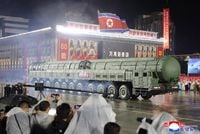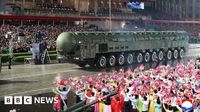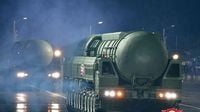On the rainy night of October 10, 2025, Pyongyang’s Kim Il Sung Square was awash with glimmering lights, thunderous cheers, and the unmistakable rumble of military hardware. North Korean leader Kim Jong Un presided over a grand military parade, marking the 80th anniversary of the Workers’ Party of Korea’s founding—a spectacle that doubled as both a show of military might and a bold diplomatic overture to the world. With thousands of troops, a dazzling fireworks display, and a procession of the country’s most advanced weaponry, the event was as much about pageantry as it was about power.
At the heart of the parade was the unveiling of the Hwasong-20 intercontinental ballistic missile, which North Korean state media KCNA described as the nation’s “most powerful nuclear strategic weapon system.” The missile, wheeled out on imposing 11-axle launchers, drew the loudest cheers from the crowd—an audience that included not just North Korean citizens, but also a rare assembly of high-ranking foreign dignitaries. Among them were Chinese Premier Li Qiang, former Russian President and current deputy head of Moscow’s Security Council Dmitry Medvedev, and Vietnam’s Communist Party leader To Lam.
The presence of such international figures was no accident. As reported by Reuters and UPI, Kim took the central podium flanked by Li and Lam, with Medvedev standing close by—a tableau that sent a clear message about North Korea’s growing diplomatic ambitions and its efforts to break out of international isolation. The parade, as KCNA noted, was a demonstration not only of military prowess but also of Pyongyang’s increasingly assertive foreign policy. The event followed a series of high-level meetings, including Kim’s recent visits to Beijing and his summit with Chinese President Xi Jinping and Russian President Vladimir Putin at a military parade in China. Kim also held one-on-one talks with both Li and Lam in the days leading up to the anniversary, signaling renewed diplomatic energy.
Yet, for all the diplomatic handshakes, the spotlight was firmly on North Korea’s military advancements. The Hwasong-20 ICBM, making its public debut, represents the “apotheosis of North Korea’s ambitions for long-range nuclear delivery capabilities,” according to Ankit Panda of the Carnegie Endowment for International Peace, as quoted by Reuters. Panda added, “We should expect to see the system tested before the end of this year.” The missile is believed to be designed for multiple warheads—an innovation that would significantly increase the stress on existing U.S. missile defense systems and, in Kim’s view, provide the necessary deterrence against Washington.
Despite the impressive display, experts remain cautious about the true capabilities of the Hwasong-20. While the missile series theoretically gives North Korea the ability to strike anywhere in the United States, questions linger about its guidance system’s precision and whether its warhead could survive the intense heat and pressure of atmospheric re-entry. As noted by the BBC and Reuters, these technical hurdles mean that, for now, the missile’s threat is more about potential than proven performance.
North Korea’s push for solid-fuel missiles, highlighted by the recent test of a new engine made with carbon fiber composites, is another key development. Solid-fuel missiles can be moved and launched more quickly than their liquid-fueled counterparts, making them harder to detect and intercept. State media boasted that the new engine is more powerful than past models and is intended for future ICBMs, a point that has not gone unnoticed by analysts and foreign governments alike.
The parade was not limited to the Hwasong-20. Spectators were treated to a rolling exhibition of North Korea’s expanding arsenal: medium- and long-range strategic missiles, cruise and hypersonic missiles, drone launch vehicles, Chonma-20 battle tanks, 155mm howitzers, and 600mm multiple rocket launchers. Kim’s focus on modernizing both nuclear and conventional forces was clear, with the country’s latest drones and artillery systems rolling past the grandstand to the roar of the crowd.
Kim’s address during the parade was characteristically defiant. “Our army should continue to grow into an invincible entity that destroys all threats approaching our range of self-defense,” he declared, as reported by KCNA and UPI. He praised the “ideological and spiritual perfection” of North Korea’s military and called for it to “steadily strengthen itself into elite armed forces which win victory after victory.” Notably, Kim made no direct mention of the United States or South Korea, but the subtext was clear: North Korea is determined to continue its military buildup regardless of international pressure or sanctions.
One of the most striking elements of the parade was the acknowledgment of North Korean troops serving abroad, particularly those deployed to Russia in the ongoing war against Ukraine. Kim offered “warm encouragement” to these soldiers, lauding their “heroic fighting spirit” and their role in what he described as a battle for “international justice and genuine peace.” Russian dignitary Dmitry Medvedev echoed this sentiment, praising the “bravery and self-sacrificing spirit” of North Korean soldiers fighting alongside Russian forces. According to KCNA, Kim expressed his desire to further strengthen cooperation with Russia and to engage in “diverse exchanges to achieve mutual goals.”
These overtures to Russia and China come at a time when North Korea has refused to engage in talks with Washington and Seoul since the collapse of negotiations with former U.S. President Donald Trump in 2019. Kim has repeatedly urged the United States to drop its demand for North Korean denuclearization as a precondition for resuming diplomacy. Instead, Pyongyang has sought to build a united front with Beijing and Moscow, positioning itself as a key player in the geopolitical contest with the U.S.-led West.
The parade, with its combination of military bravado and diplomatic choreography, underscored the complex reality of North Korea’s current strategy. On one hand, Kim is pushing hard to develop weapons that could shift the balance of power in East Asia and beyond. On the other, he is actively courting allies, seeking to leverage his country’s military progress into greater international legitimacy and economic support. The enthusiastic reception from both the domestic audience and foreign guests was a testament to the regime’s ability to orchestrate a message of strength and unity.
As the night drew to a close, with fireworks lighting up the Pyongyang sky, Kim’s ambitions were on full display. Whether the Hwasong-20 will live up to its billing remains to be seen, but the world is watching closely. For North Korea, the parade was more than a celebration—it was a declaration of intent, both to its people and to its rivals abroad.


